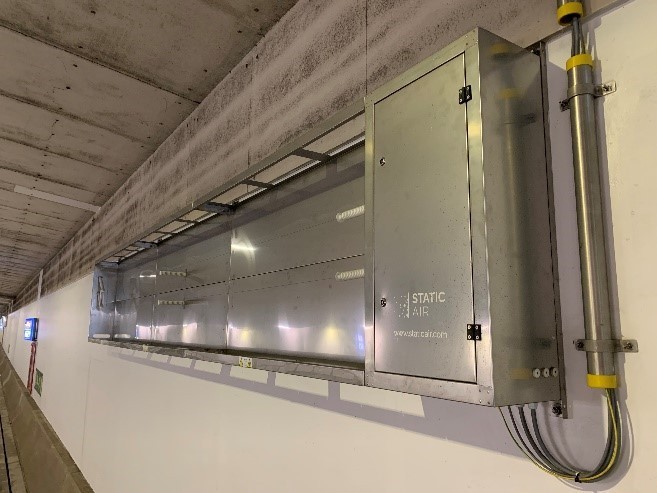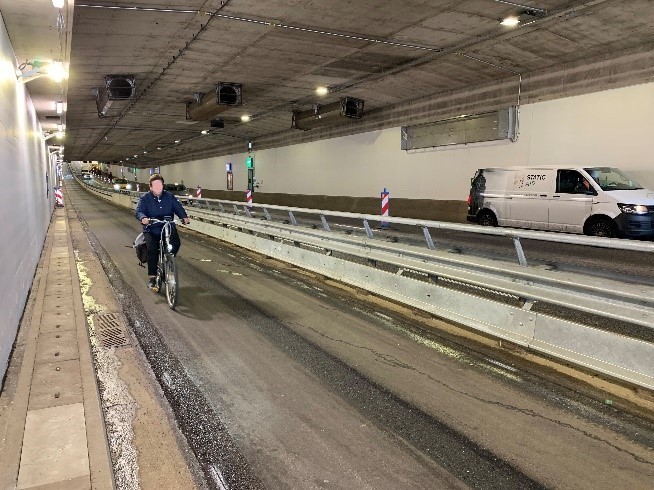Note: This is an English translation of the Dutch post, originally located at Vridiair Blog
Have you ever noticed that a tunnel is full of particulate matter and combustion gases, caused by the heavy traffic that passes through it every day? In our latest blog, we delve into the impact of polluted tunnel air on residents and unveil our solution. While tunnels are notorious for affecting the health of traffic users, we often overlook the well-being of nearby residents. The latter is a theme that is often overlooked, but not with StaticAir. With all the urban infrastructures, it is important to understand how we can purify the air in a tunnel and ensure the health of local residents.
Tunnels and air quality
Tunnels pose unique air quality challenges. The constant flow of traffic, vehicle emissions, and construction materials all contribute to poor air quality. Cleaning the polluted indoor air in a tunnel, through air purification, has therefore become a fundamental aspect of the design and operation of tunnels, aimed at maintaining a healthy air level for local residents. That's where StaticAir steps in. StaticAir is an expert in the field of and have the most effective solution with the patented FDRS system. Air purification in tunnels and have the most effective solution with the patented FDRS system.
The FDRS is equipped with a patented and certified ionization technology by TNO and designed in collaboration with Tu Delft. The FDRS system efficiently reduces and captures particulate matter particles from traffic emissions in tunnels. The big advantage of this system is that energy consumption is low and expensive filters do not have to be changed periodically.

Impact of tunnel emissions on local residents
The impact of tunnel emissions on the health of local residents is enormous. The combustion process of vehicles in tunnels generates a complex mix of pollutants, including carbon monoxide, nitrogen oxides and particulate matter. When these particles leave the tunnels unfiltered, they can have a negative impact on the air quality in the immediate area and cause health problems.
Studies have shown that long-term exposure to these emissions can lead to health problems such as respiratory disease, cardiovascular disease, and other conditions. It is therefore important to implement sustainable measures such as air purification to protect the health of local residents.
Designing tunnels with minimal emissions through air purification
Integrating advanced air purification systems is key to reducing emissions in tunnels. These systems are designed to effectively clean tunnel emissions and supply clean air to the immediate environment.
Systems, like the FDRS air purification system, play a pivotal role in reducing the concentration of harmful substances. Its passive air purification method ensures minimal energy consumption, making it an eco-friendly choice for tunnel design (18 Watts).

Examples of healthy tunnels in the Netherlands
The Kiltunnel , the connection between the Island of Dordrecht and the island of Hoeksche Waard, is a good example of a healthy tunnel in the Netherlands. Together with StaticAir, the tunnel has ensured fewer emissions for local residents. The Kiltunnel is a main artery for both car traffic and (moped) cyclists. Within the tunnel, StaticAir has a total of 20 systems that together reduce particulate matter by 57% (PM 2.5 - PM 10)
The most sustainable tunnel in Europe is another example of a tunnel where StaticAir has improved air quality. The tunnel is a busy main access road to The Hague. With 2 lanes in both directions, it is the most sustainable tunnel in Europe, partly thanks to our system. Our technology guarantees a reduction of particulate matter (PM 2.5 - PM 10) by at least 55%, ensuring clean air for everyone traveling through the tunnel and residing nearby.
Community involvement and future prospects
In addition to technological innovation with air purification and sustainable design considerations, local community involvement is vital. Awareness of the impact of emissions in tunnels, education and involving local residents in the design process fosters a sense of ownership and ensures sustainable outcomes.
Looking ahead, StaticAir is looking at promising developments, such as the rise of electric vehicles, which prevent traditional combustion gases from entering the tunnel. However, electric cars also continue to emit particulate matter (particularly from the tires), which means that air purification will continue to be necessary in the future.
StaticAir remains committed to continuous research and innovation to develop sustainable solutions that protect the health of local residents and minimize environmental impact.
A healthy future for tunnel residents with appropriate air purification
The health of tunnel residents is a crucial aspect of urban planning and infrastructure development. Leveraging advanced air purification technologies from StaticAir and fostering community engagement serve as the building blocks of a sustainable future for those residing in tunnel vicinity.



